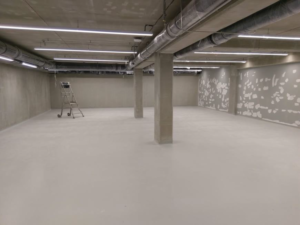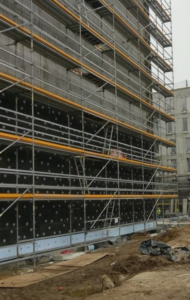First in Poland storage facilities for heritage resources with passive control of climate
Energy costs are one of the largest expenditure category in many institutions preserving cultural heritage assets – museums, libraries or archives. Saving energy is, therefore, of a vital economic interest to the memory institutions. Universal requirements of sustainable development, in terms of reducing energy use and carbon emissions, play also an important role. From such perspective, to reduce energy consumption in buildings of museums or archives has not only economic but also ecological and ethical aspect – it means implementing idea of a ‘green museum’ which preserves heritage while respecting natural environment and limited resources.
In the years 2014 – 2015, experts of the Institute’s Cultural Heritage Group developed a concept for a storage facility in a new seat of the National Archive in Krakow, for the first time in Poland combining high standards of collection care with a very low energy consumption in an operating building. The storage building with seven levels over ground and one underground will ultimately house 70 000 linear metres of records and has allowed records from five Krakow departments of the Archive and the branch in Spytkowice near Zator to be united. Since 2020, the institute’s experts support Archive’s staff in making the storage facility operational and safe moving of the collections to the new seat.
 |
| New seat of the National Archive at Rakowicka street in Krakow. A cuboid structure of the storage facility in the foreground. |
How does the Krakow archive storage facility with passive climate control operate?
The storage facility is a separate structure in which there is no permanent workspace and the environmental conditions serve collection preservation. Offices, reading rooms, conservation and collection digitalization areas, server rooms as well exhibition and education areas are placed in the adjacent air-conditioned office building. To a great extent passive stabilization of microclimate was achieved through specifically introduced building features: good thermal insulation of outer walls and the roof, high airtightness of the building envelope, enhanced by lack of windows, use of porous building materials of good capacity to exchange water vapour on the architectural surfaces.
 |
 |
| Typical storage space (left), with the exception of ventilation ducts under the ceiling and lighting, no technical installations which can pose a risk to the collections stored, are placed in the interior. Building’s outer walls possess good thermal insulation (right). | |
The Krakow storage facility was made operational in spring 2020. The measurements carried out have revealed that the indoor temperature followed the yearly cycle of temperature changes outdoors attaining in February 2021 its lowest value of between 11 and 14 oC depending on the floor. Most of the year – between October and June – relative humidity stayed spontaneously at an optimum level of 50% with small short-term fluctuations. In the summer period, air is dehumidified by energy-efficient dehumidifiers. Dry conditions and low temperature during the most part of the year limit the rate of chemical degradation of archival objects, and the high airtightness of the building reduces infiltration of air pollutants from outdoors.
National Institute for Museums and Public Collections (NIMOZ) will build a shared storage centre for several museums close to Warsaw
Since 2019, experts of the Institute’s Cultural Heritage Group work within a task force on the Central Storage Facility for Museum Collections at the NIMOZ. The aim of the project is to build a shared storage facility for Warsaw museums which will combine high quality of collection care with low energy use during the operation. Situated on a large piece of land close to Warsaw, the investment will involve a joint development of storages and spaces for management, conservation, documentation of the resources preserved and access to them. As in the storage facility in Krakow, passive – to a great extent – stabilization of the environmental conditions will be implemented. An innovative project involving a shared storage facility paves the way for new solutions in Polish museums favouring sustainable preservation of heritage assets.